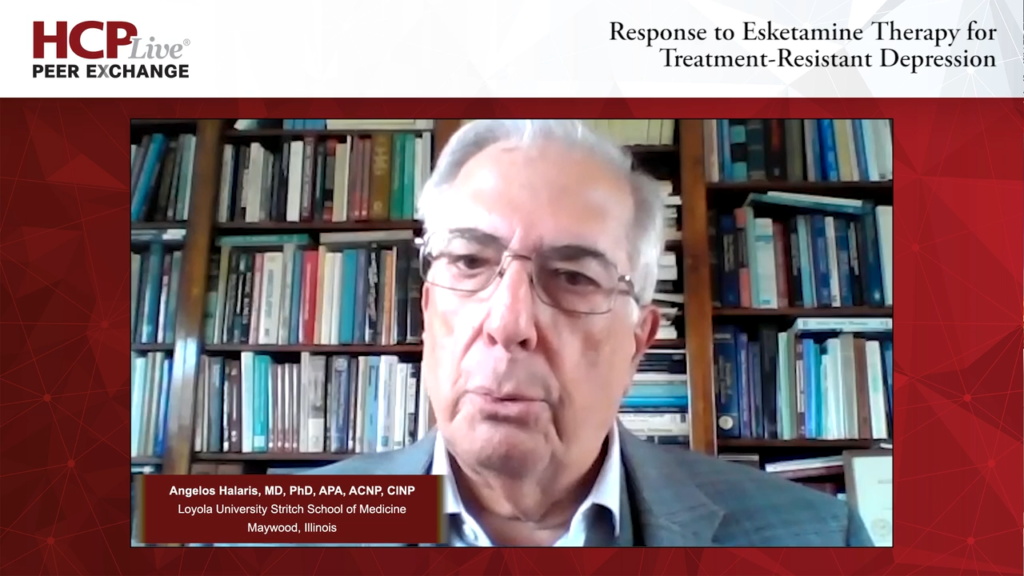Steven Levine, MD: All 3 of you have experience prescribing intranasal esketamine in a carefully screened population for an appropriate patient under careful medical conditions, so this question is for any of you. What is typical? How quickly do you tend to see improvements in depressive symptoms for these patients when they do respond?
Lisa Harding, MD: In my experience, everybody has a response after the first treatment. The crux of the matter comes in the durability of that response. I have a big complaint about the psychiatric scales that we use. It’s half and half with how my patient is doing subjectively. I use a PHQ-9 [Patient Health Questionnaire-9] and MADRS [Montgomery-Asberg Depression Rating Scale]. Somebody can have a very low MADRS or PHQ-9 score that is indicative of remission and response, but if they’re still answering, “Yes, I’m having suicidal thoughts every day,” I don’t know if I count that as a win clinically.
For me, it’s half and half. My follow-ups are much closer if I’m treating suicidal ideation. Anecdotally and personally, that is the first symptom that tends to go if you’re looking at the MDSI [major depressive disorder with suicidal ideation] population. Within the first 24 hours, I definitely notice if it’s durable for that particular patient. Because we’re not doing this treatment in a vacuum, most patients strangely have their psychotherapy appointment right after either their infusion or nasal insufflation. I’m waiting on science to run the data on that clinical trial as to whether it’s more efficacious after they get ketamine.
Steven Levine, MD: Yes, that’s a great question. Patricia and Angelos, how about you? How quickly do you tend to see improvements?
Patricia Ares-Romero, MD, FASAM: My experience is pretty much the same. Within the first 24 hours, we see some response. I’ve had patients where it’s taken 4 weeks for them to feel much better, so it goes both ways. They all respond—usually within the first 24 hours—which is really nice to see when the patient comes back for the second treatment and they’re feeling better. We also use the PHQ-9s and MADRS to make sure the insurance pays too.
Angelos Halaris, MD, PhD, APA, ACNP, CINP: I don’t want to sound too negative about it. We do see a response after the first administration. I don’t want to be a devil’s advocate, but is that a true response or a placebo effect?
Lisa Harding, MD: I will interrupt you for 2 seconds. There’s no such thing as a placebo effect. There are the nonspecific, nonpharmacological effects that occur.
Angelos Halaris, MD, PhD, APA, ACNP, CINP: OK, I’ll grant you that, Lisa. Be that as it may, the initial response to the first administration response is a sense of relaxation and feeling lighter, even if it’s at least in part placebo because it’s a brand-new treatment and the expectations are high and, therefore, the person must feel better. The effects after the first—or even second—administration doesn’t last long, so the recommendation, if not mandate, of twice a week for the first 4 weeks is very appropriate.
In my experience, we start seeing more stable response improvements after 2 to 3 weeks on average and then the patient goes home. Let’s say the administration was given on a Thursday and they come back on a Monday or Tuesday the following week. The effects usually last longer and longer into the intervening weekend and eventually become more stable and more pervasive. That’s when we can say, “OK, now I can afford to have you come once a week, and down the road, once every other week.” That’s the approach I’ve taken. For the most part, it has proven to be the right approach.
Lisa Harding, MD: Absolutely. Having been on clinical trials myself, we all know that the data in the clinical trial is a result of you seeing maybe 2 or 3 doctors. There are all these people fussing about you. It’s somewhat replicated in esketamine and racemic ketamine administrations. You’re coming in, being attended to, and being monitored. I agree with you. This definitely needs to continue to be studied. How do we enhance all of our long-term treatments? Is it that we bring somebody with sertraline in and put them in a fancy room and also administer it under those conditions? Would our adherence and our outcomes be better? Maybe.
Steven Levine, MD: Yes, Lisa. You mentioned the nonspecific effects of treatment. Certainly, intranasal esketamine is a high-touch treatment and perhaps an advantage if we’re trying to leverage any aspect of mechanism that might help our patients feel better and feel better sooner. To echo what Angelos said—I’ll chime in with my own experience with both IV [intravenous] ketamine and intranasal esketamine—it’s very gratifying to see these very rapid responses that can be almost immediate. Certainly, that immediate response may not be fully consistent or durable. It does seem that the accumulation of treatments over a period of time has an additive effect and helps to extend that durability of response. I recognize that when I say “seems to be,” it would be better to actually measure those outcomes so we have something to validate it. It sounds like all of you are measuring outcomes, which I applaud you for. As you know, that’s not necessarily the case in all practices.
Thank you for watching this HCPLive® Peer Exchange. If you enjoyed the content, please subscribe to our e-newsletters to receive upcoming Peer Exchanges and other great content right in your inbox.
Transcript Edited for Clarity
